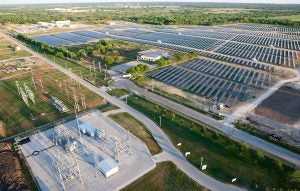 New installed renewable energy capacity surpassed coal for the first time last year, the International Energy Agency reported recently.
New installed renewable energy capacity surpassed coal for the first time last year, the International Energy Agency reported recently.
It means that we added more wind and solar to our global energy system than oil, gas, coal or nuclear power combined – a trend that is expected to continue over the next five years.
But to truly transition to a global clean energy economy, we must accelerate this growth rate and modernize our electricity grid to maximize the potential of these new renewables. That way we can use as much clean energy as possible on any given day.
Many of these optimizing solutions already exist today.
They include technology such as powerful batteries that can store energy when renewables don’t produce electricity, for example, when the sun is shaded by a cloud.
There are also energy management tools such as demand response that pay customers for saving energy at critical times when the grid needs it. And innovative electricity pricing programs that encourage customers to shift some of their power use to times of day when clean energy sources are plentiful and electricity is cheaper.
All can, with the help of good policy, make the most of variable energy sources – as would a modernized and more dynamic electric grid.
A flexible energy system paves the way
Between now and the end of 2021, the United States will add around 100 gigawatts of new renewables, the equivalent of about 80 coal plants, the IEA reported. To integrate and value all this new, clean energy we need a smart and forward-looking grid strategy.
Because our energy system was initially designed for large, centralized power plants running mainly on fossil fuels, it depends on a steady supply of power and a network of transmission lines to deliver it to peoples’ homes and businesses.
As we expand smart grid solutions that empower businesses and households to make and move their own energy – for example, by selling solar power back to the grid – we begin to build a more flexible energy system that can accommodate intermittent sources of electricity and increased elasticity in demand. It also helps people reduce their power consumption and energy bills when they see that the cost of electricity fluctuates at different times.
A smart grid can detect when one house can’t use all the rooftop solar energy it produces and shift that electricity to the family next door that is charging an electric vehicle or running an air conditioning unit. It avoids using costly transmission systems to move power where it’s needed, reduces emissions and creates space for new and cleaner energy sources to move in.
A larger grid makes renewables go farther
But we must also expand the grid to allow for an influx of new renewable generation, or we may risk wasting even more precious resources.
If California’s electric grid were connected to neighboring states, for example, the state could export its excess renewable energy when the sun is shining there, and buy wind from Wyoming when it isn’t. This, again, would make wind and solar go farther.
The surge in renewable investments can change the equation – but it’s up to us to break down barriers and pave the way.
The rapid deployment of renewable energy technology worldwide is putting in place critical infrastructure and volume needed for a shift away from polluting fossil fuels.
But this growth needs to continue and accelerate. Renewable energy has a lot of catching up to do with coal and natural gas, which are enjoying a decades-long head start on infrastructure and investment.
Even though U.S. investment in clean energy soared from an impressive $10 billion to $56 billion between 2004 and 2015, renewables still represent a tiny fraction of the power produced by the American electricity sector. Nationwide, wind accounts for less than 5 percent and solar for less than 1 percent.
The surge in renewable investments can change the equation – but it’s up to us to break down barriers and pave the way for the clean energy economy. We have the solutions and know what to do.
This post originally appeared on our EDF Voices blog.
Photo source: CPS Energy









